Related Research Articles
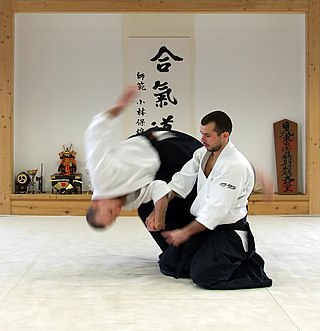
Aikido is a modern Japanese martial art which is split into many different styles including Iwama Ryu, Iwama Shin Shin Aiki Shuren Kai, Shodokan Aikido, Yoshinkan, Renshinkai, Aikikai, and Ki Aikido. Aikido is now practiced in around 140 countries. It was originally developed by Morihei Ueshiba, as a synthesis of his martial studies, philosophy and religious beliefs. Ueshiba's goal was to create an art which practitioners could use to defend themselves while also protecting their attackers from injury. Aikido is often translated as "the way of unifying (with) life energy" or as "the way of harmonious spirit". According to the founder's philosophy, the primary goal in the practice of aikido is to overcome oneself instead of cultivating violence or aggressiveness. Morihei Ueshiba used the phrase masakatsu agatsu katsuhayabi" to refer to this principle.
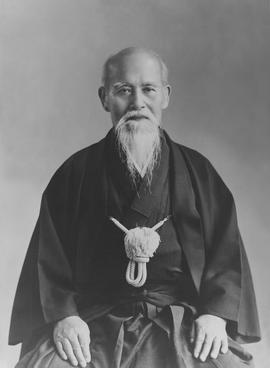
Morihei Ueshiba was a Japanese martial artist and founder of the martial art of aikido. He is often referred to as "the founder" Kaiso (開祖) or Ōsensei (大先生/翁先生), "Great Teacher".

Daitō-ryū Aiki-jūjutsu, originally called Daitō-ryū Jujutsu, is a Japanese martial art that first became widely known in the early 20th century under the headmastership of Takeda Sōkaku. Takeda had extensive training in several martial arts and referred to the style he taught as "Daitō-ryū". Although the school's traditions claim to extend back centuries in Japanese history there are no known extant records regarding the ryū before Takeda. Whether Takeda is regarded as either the restorer or the founder of the art, the known history of Daitō-ryū begins with him. Takeda's best-known student was Morihei Ueshiba, the founder of Aikido.
In Japanese martial arts, Irimi (入り身) is the act of entering straight into a technique, as opposed to the more indirect entrance into technique called tenkan. In basic training, irimi usually looks like a step forward, straight or at an angle but usually ending with the body facing the attacker, rather than in the direction of the step. To enter with irimi, the defender needs to move in the very moment of the attack or even himself initiate it.
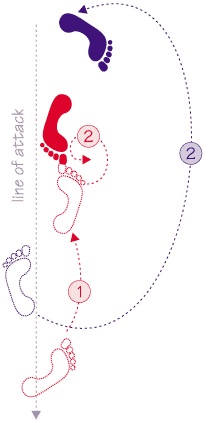
Tenkan is the Japanese name of a movement practiced in several martial arts. It is a 180 degree pivot to the rear, on the lead foot. That is, if the left foot is forward, the pivot is clockwise, and if the right foot is forward, the pivot is counter-clockwise.
Morihiro Saito was a teacher of the Japanese martial art of aikido, with many students around the world. Saito's practice of aikido spanned 56 years, from the age of 18, when he first met aikido founder Morihei Ueshiba, until his death in 2002.

Japanese martial arts refers to the variety of martial arts native to the country of Japan. At least three Japanese terms are used interchangeably with the English phrase Japanese martial arts.
Iwama-style Aikido(岩間合気道) is the style of aikido that was taught in Iwama by the founder of aikido, Morihei Ueshiba, and especially the lineage passed on through Morihiro Saito, a close disciple who was given responsibility over Iwama dojo by Ueshiba.
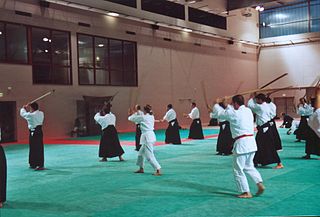
Aiki-ken is the name given specifically to the set of Japanese sword techniques practiced according to the principles of aikido, taught first by Morihei Ueshiba, then further developed by Morihiro Saito, one of Ueshiba's most prominent students. Currently, Iwama Shin-Shin Aiki Shuren-kai is the main proponent organization.

Shoji Nishio was a Japanese aikido practitioner and innovator. He held the rank of 8th dan shihan from the Aikikai. He also achieved multiple high ranking honors in other martial arts from different lineages, most notably Iaido, Judo, Karate.
Kanshū Sunadomari was a Japanese aikido teacher who was an uchideshi to the founder of aikido, Morihei Ueshiba. He founded the aikido style Manseikan Aikido.
Seiseki Abe was a Japanese shodo and aikido teacher who had a unique relationship with aikido founder Morihei Ueshiba, being both his student in aikido and his teacher in calligraphy.

Tai sabaki (体捌き) is a term from Japanese martial arts and which relates to 'whole body movement', or repositioning. It can be translated as body-management. It is a term used widely in and very important in kendo, jujutsu, aikido, judo, karate and ninjutsu. Tai sabaki is usually used to avoid an attack, such that the receiver of the attack ends up in an advantageous position and it is often wrongly referred to as evasion.
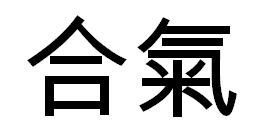
Aiki, a Japanese budō term, at its most basic is a principle that allows a conditioned practitioner to negate or redirect an opponent's power. When applied, the aiki practitioner controls the actions of the attacker with minimal effort and with a distinct absence of muscular tension usually associated with physical effort.
Aiki-jō is the name given specifically to the set of martial art techniques practiced with a jō, according to the principles of aikido. Jō techniques were introduced into aikido by Morihei Ueshiba, aikido's founder, and further developed by Morihiro Saito, one of Ueshiba's most prominent students.

Yoseikan Aikido is the aikido taught at the Yoseikan Dojo in Shizuoka, Japan, under the direction of Minoru Mochizuki.
Aikido techniques are frequently referred to as waza 技. Aikido training is based primarily on two partners practicing pre-arranged forms (kata) rather than freestyle practice. The basic pattern is for the receiver of the technique (uke) to initiate an attack against the person who applies the technique—the 取り tori, or shite 仕手, also referred to as (投げ nage, who neutralises this attack with an aikido technique.
Alan Ruddock was an Irish Martial Arts pioneer, teacher and writer. He introduced both Aikido & Karate to Ireland and was the founder of the Aiki no Michi and its interpretation of Aikido. Ruddock was one of the few western Aikido practitioners and only Irish national who studied directly under the founder of Aikido, Morihei Ueshiba ("O-Sensei").

Stanley A. Pranin was an American martial artist, founding publisher, and editor-in-chief of Aikido Journal. Pranin, a researcher and archivist of aikido, has written and published several books and many articles about aikido, Daito-ryu Aikijujutsu, and Morihei Ueshiba and was an influential figure in the aikido world.
Nishio style Aikido, often simply referred to by Aikido practitioners as Nishio Aikido, is a martial art style created by Shoji Nishio, a prolific Aikido practitioner. His style is characterized as dynamic and effective. Atemis and sword principles are deeply embedded in techniques.
References
- ↑ "- YouTube". YouTube .
- ↑ "正勝吾勝". 2009-04-10. Retrieved 2 September 2010.
- ↑ "Agatsu: 吾勝". Aikiweb. Archived from the original on 27 September 2011. Retrieved 2 September 2010.
- ↑ "Aikido Journal: satsujinken". Archived from the original on 2012-09-19. Retrieved 2010-10-05.
- ↑ "Aikido Journal: Katsujinken". Archived from the original on 2012-09-19. Retrieved 2010-10-05.
- ↑ Pranin, Stanley A. (1993). Aikido Masters Vol I. Tokyo, Japan: Aiki News. pp. 10–11, 167. ISBN 4-900586-14-5.
- ↑ Ueshiba Morihei, Compiled by Stevens, J (1993). The Essence of Aikido. Japan: Kodansha. pp. 16, 29–30, 43, 45, 55, 82, 84, 89, 91. ISBN 4-7700-1727-8.
{{cite book}}: CS1 maint: multiple names: authors list (link) - ↑ Ueshiba Morihei, Compiled by Stevens, J (1993). The Essence of Aikido. Japan: Kodansha. pp. 39–94. ISBN 4-7700-1727-8.
{{cite book}}: CS1 maint: multiple names: authors list (link) - ↑ "Yamabiko no michi".